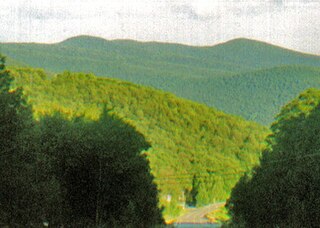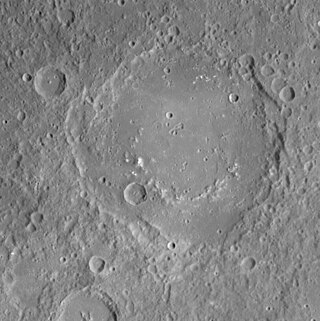Baranauskas is the masculine form of a Lithuanian family name. Its feminine forms are: Baranauskienė and Baranauskaitė.

Panther Mountain is one of the Catskill High Peaks, located in the Town of Shandaken in Ulster County, New York. At approximately 3,720 feet (1,130 m) in elevation, it is the 18th highest in the range. A combination of factors has led some geologists to believe the mountain is on the site of an ancient meteorite impact crater.

Yeats is an impact crater on the planet Mercury. The crater is named after William Butler Yeats, an Irish poet and dramatist. The name was adopted by the International Astronomical Union in 1976.

Sholem Aleichem is a crater on Mercury, named after the Yiddish writer Sholem Aleichem. The inter-crater plain deposits have been deformed by linear ridges.

Matisse is an impact crater on the southern hemisphere of Mercury. Matisse takes its name from the French artist Henri Matisse, and it was named by the IAU in 1976.

Eminescu is a peak ring crater on Mercury 125 kilometers (78 mi) in diameter. Since there are very few later craters superposed on it, Eminescu appears to be a young crater formed around one billion years ago. It has a transitional morphology between larger more complex impact basins like Raditladi and smaller simpler central peak craters.

Xiao Zhao crater is small in comparison with many other craters on Mercury. However, Xiao Zhao's long bright rays make it a readily visible feature. The fresh, bright rays, which were created by material ejected outward during the impact event that formed the crater, indicate that Xiao Zhao is a relatively young crater on Mercury's surface.

Located in the western edge of Mercury's giant Caloris basin, Kertész crater has some unusual, bright material located on its floor. Sander crater, located in the northwestern edge of Caloris basin, also shows bright material on its floor. Just northeast of Kertész a small crater has very bright rays and ejecta, indicating that the crater is young.

Sander is a crater on Mercury within Caloris Basin. It has dark walls and bright patches on its floor. Unlike the rays of Bashō crater, the bright areas are not believed to be immature, but they are inherently bright. It is named after the German photographer August Sander (1876–1964).

Praxiteles is a crater on Mercury. It is one of 110 peak ring basins on Mercury.

Aksakov is a crater on Mercury. It has a diameter of 174 kilometers. Its name was adopted by the International Astronomical Union (IAU) on April 24, 2012. Aksakov is named for the Russian author Sergey Aksakov, who lived from 1791 to 1859 C.E.

Al-Hamadhani is a crater on Mercury. It has a diameter of 186 kilometers. Its name was adopted by the International Astronomical Union in 1979. Al-Hamadhani is named for the Iranian writer Badi' al-Zaman al-Hamadani, who died in 1007 C.E.

Bartók is a crater on Mercury. Its name was adopted by the International Astronomical Union (IAU) in 1979. Bartók is named for the Hungarian composer Béla Bartók, who lived from 1881 to 1945.

Darío is a crater on Mercury. It has a diameter of 151 kilometers. Its name was adopted by the International Astronomical Union (IAU) in 1976. Dario is named for the Nicaraguan poet Rubén Darío, who lived from 1867 to 1916.

Geddes is a crater on Mercury. It has a diameter of 84 kilometers. Its name was adopted by the International Astronomical Union (IAU) in 2010. Geddes is named for the Irish stained glass artist Wilhelmina Geddes, who lived from 1887 to 1955.

Giotto is a crater on Mercury. It has a diameter of 144 kilometers. Its name was adopted by the International Astronomical Union (IAU) in 1976. Giotto is named for the Italian painter Giotto di Bondone, who lived from 1271 to 1377.

Hitomaro is a crater on Mercury. It has a diameter of 105 kilometers. Its name was adopted by the International Astronomical Union (IAU) in 1976. Hitomaro is named for the Japanese poet Kakinomoto no Hitomaro, who lived from the 650s to roughly 709.

Balanchine is a crater on the planet Mercury. It possesses a ray system of slightly bluish rays. These rays inspired the name of the crater due to their similarity to the tutu in George Balanchine's Serenade.

Kulthum is a crater on Mercury. It has a diameter of 31 kilometers. Its name was suggested by Molouk Ba-Isa from Saudi Arabia, Swiss individual Riana Rakotoarimanana, and American residents Yehya Hassouna, David Suttles, Thorayya Said Giovannelli and Matt Giovannelli in a naming contest which was eventually adopted by the International Astronomical Union (IAU) on 2015. Kulthum is named for the Egyptian singer Umm Kulthum.
Hollows are a landform on the planet Mercury, discovered during the MESSENGER mission that orbited the planet from 2011 to 2015.




















